Kempinski's Quinnimont and Laurel Creek NTRAK Modules
by Bernard Kempinski updated 2 June 1999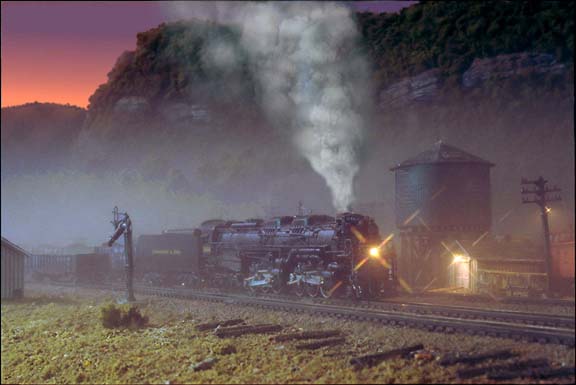
Quinnimont is a natural NTRAK candidate location because of the presence of three or more parallel tracks. While the C&O New River Subdivision is primarily a two track main, fortunately for us, most of the operationally significant and interesting locations along the New River have three or more parallel tracks.
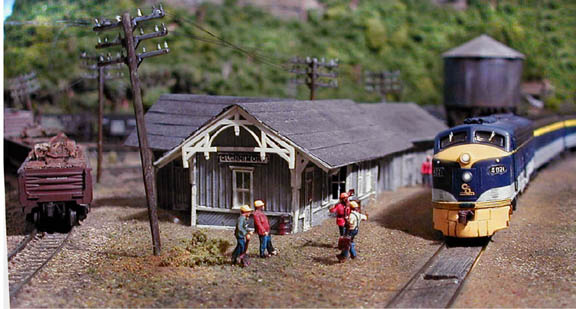
I decided to begin building a Tee Module based on Matt Schaefer's Quinnimont Plan that was shown in the NVNTRAK newsletter in 1995. I have taken Matt's plan and adapted to fit in my car and made some other minor changes to make it more accurately reflect the prototype using data provided by the C&O historical society . The track plan for the Quinnimont module closely reflects the prototype. In later years the C&O added a number of yard tracks between the river and the main line. I chose to model an earlier track configuration but I'm considering adding one or two tracks to front of the module to reflect the later configuration as I have provided for this in the plan. To make room for the QN Cabin the module is 6 feet long but notched on the east end to 18 inches wide to allow it to fit in a compact car. The Laurel Creek module includes a non-prototypical trestle to carry the high line track.
The drawing also shows the track plan for the Quinnimont Tee and a three foot corner that mates with it, which I call Laurel Creek in accordance with the prototype.  When laying out the track plan for a new Tee one thing you must consider is the possibility of a reverse loop formed when the yellow line is connected to the both the red and the blue. The connection that causes the reverse might not be on your module. When laying out the track plan for a new Tee one thing you must consider is the possibility of a reverse loop formed when the yellow line is connected to the both the red and the blue. The connection that causes the reverse might not be on your module.
The wiring for these Tee modules is a little tricky and it's worth sharing some thoughts on this for future Tee builders. One innovation that I developed for this module is the pig tail reversing connection. These should allow us to quickly set-up the module in normal or reverse mode without the need for additional reversing connectors. Basically the power bus for each NTRAK line on the module has two connectors on each end: a normal connector and a reversing connector. For example track 1, normally the red line, has a normal male Cinch Jones on the right hand side color coded red and a female Cinch Jones color coded blue spliced to the same power bus but wired with wide pin to the rear rail. If you plugged these two pig tail connectors together you'd get a dead short (however, I tried to make the pig tail short enough to avoid this possibility). Thus to hook up this module you would position it in the correct configuration according to the layout plan and then plug into the adjacent modules with the connectors that fit following the proper color code and pin orientation. I've labeled the connects normal and reverse to help decipher the situation since when you looking upside down in the dark it's sometime hard to figure out what is going on. If all goes according to plan there will be only one correct way to plug these in and it should be somewhat fool proof.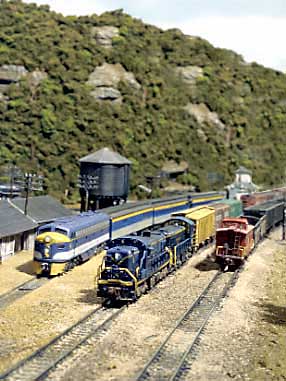
The white line was easier to rig since it is not connected to rails that change polarity when the track geometry changes. Basically I attached the white power bus in the center of the module with long enough leads that they can be stretched in the direction that matches the pin polarity.
There are several options for wiring the Tee (or Wye) tracks. In my case since Laurel Creek will normally attach to Quinnimont, I connected the plugs that lead to Laurel Creek side to the power feeds of the line the rail attaches to, in others words, I followed the normal NTRAK standard without embellishment. There are no blocks or block switches to throw. So even if the Quinnimont module is reversed, the connections between Laurel Creek and Quinnimont don't change. The disadvantage of this simplicity is that no separate throttle can be used on the Quinnimont module.
Furthermore, the Wye tracks that connect to Laurel Creek have a gap cut in them where they join Laurel Creek. The turnouts leading to the Wye tracks have power routing wiring (even though they are all live Atlas turnouts I cut gaps and wired the appropriate jumpers) such that when the turnouts are set for straight through running on Quinnimont, the Wye tracks will be dead. Thus a train that is running toward Quinnimont from Laurel Creek will encounter a stopping block as it crosses into Quinnimont module if the turnouts on Quinnimont are not set the correct way. This should help avoid having trains running across a turnout and on to the main. As in the actual Quinnimont prototype dwarf signals will also protect the main and give a red indication when the turnouts are set the wrong way.
A major complication to this project involved my decision to add a high line to the Quinnimont/Laurel Creek modules that is compatible with the high line on Matt's New River module.  The high line extension will allow an extended run on the high line when this module and Hawk's Nest are connected together at shows. Furthermore, I squeezed in an internal loop on Laurel Creek that will allow separate running on just that module when it is set up without the Hawk's Nest Module. To accommodate the internal loop I had to add a 12 inch extension to the rear of the module while keeping the overall length of the module under five feet. Both modules will fit in my Probe GT, albeit only one at a time. The high line addition is not prototypically correct for the Laurel Creek subdivision, but a photo of a West Virginia coal tipple with a high bridge running behind it provided prototypical justification plus it creates an impressive display, so I decided to go for it. The bridge is set back about 37 inches from the front of the module and there are three more feet behind it to the back drop so the view from the front is impressive. The back side is completely sceniced with a truck coal loadout as shown in the above photo. The high line extension will allow an extended run on the high line when this module and Hawk's Nest are connected together at shows. Furthermore, I squeezed in an internal loop on Laurel Creek that will allow separate running on just that module when it is set up without the Hawk's Nest Module. To accommodate the internal loop I had to add a 12 inch extension to the rear of the module while keeping the overall length of the module under five feet. Both modules will fit in my Probe GT, albeit only one at a time. The high line addition is not prototypically correct for the Laurel Creek subdivision, but a photo of a West Virginia coal tipple with a high bridge running behind it provided prototypical justification plus it creates an impressive display, so I decided to go for it. The bridge is set back about 37 inches from the front of the module and there are three more feet behind it to the back drop so the view from the front is impressive. The back side is completely sceniced with a truck coal loadout as shown in the above photo.
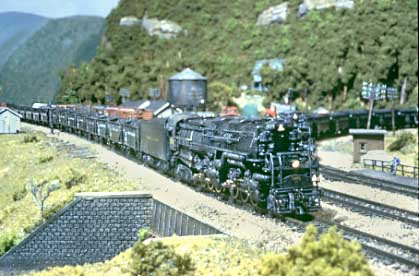 |
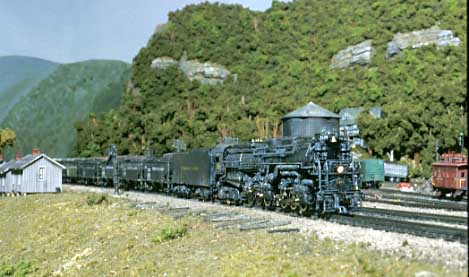 |
|